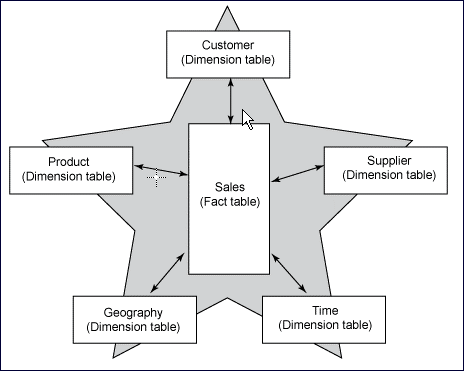Subject Area Terminology
- Last updated
- Save as PDF
The following section describes terms related to the subject areas. These are common terms relating to data warehousing, a core component of business intelligence. For more information, you can refer to the Wikipedia articles Business Intelligence and Data Warehousing.
- Star Schema – In computing, the star schema (also called star-join schema, data cube, or multidimensional schema) is the simplest style of data warehouse schema. The star schema consists of one or more fact tables that references any number of dimension tables.
- Subject Area – The data in Analytics is organized into subject areas or Data Marts. Funds Expenditure, Fulfillment, Users, and Fines and Fees are examples of subject areas.
 Star Schema
Star Schema - Fact Table – Each Fact table consists of the measurements, metrics, or facts of a business process. Often, the Fact table is located at the center of a star schema and is surrounded by Dimension tables. Each Fact table contains the core part of a subject area such as fund transactions or user loans. The relationship between a Fact table and its Dimension tables is one to many. For each entry in a Fact table, there is one record in the Dimension table.
- Dimension Table – Each Dimension table contains descriptive attributes (or fields) intended to give context to a Fact table. Typically, descriptive attributes are textual fields or discrete numbers that behave like text. Examples include Library Code, Vendor Name or Loan Date. The candidate keys (normally primary keys) found in Dimension tables refer to the business facts or measures and foreign keys contained in Fact tables.
- Attribute Column – This is similar to a column in a table in a relational data source. It holds a simple list of members which function as attributes, similar to a dimension. Examples include Library Code.
- Measure Column – This is similar to a column of data in a table in a relational data source. It holds a simple list of data values. It is a column, usually in a fact table, that can change for each record and can be added up or aggregated in some way. Examples include Transaction Amount.
- Hierarchy Column – The Hierarchical column holds lists of individual members that are shown in outline form. This means that lower level members roll up into higher level members with outline totals being shown for the higher level members, for example, a specific day that belongs to a specific month that is found in a specific year.
- Shared Dimension – Users are able to create reports that include fields from different subject areas. To do this, the report needs to include the dimension that is shared by the different subject areas.

